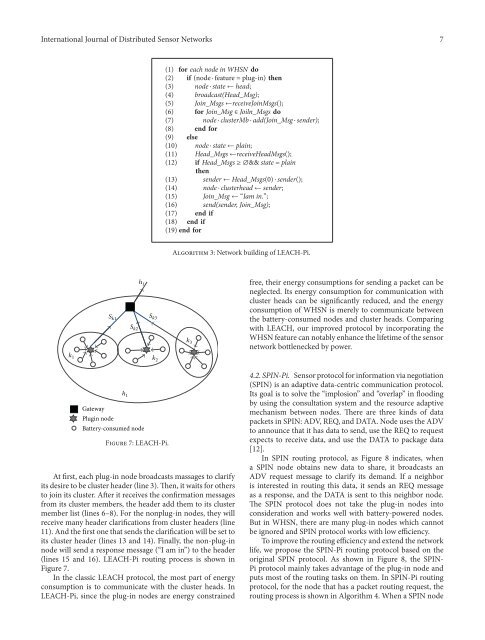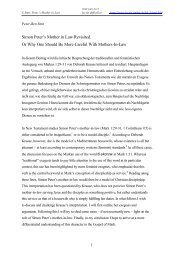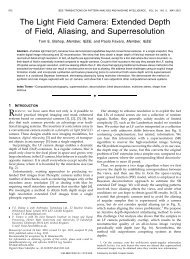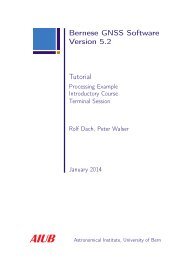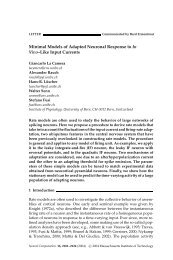Deploying Real-Life WSN Applications: Challenges ... - IAM - CDS
Deploying Real-Life WSN Applications: Challenges ... - IAM - CDS
Deploying Real-Life WSN Applications: Challenges ... - IAM - CDS
Create successful ePaper yourself
Turn your PDF publications into a flip-book with our unique Google optimized e-Paper software.
International Journal of Distributed Sensor Networks 7<br />
(1) for eachnodeinWHSN do<br />
(2) if (node ⋅ feature = plug-in) then<br />
(3) node ⋅ state ← head;<br />
(4) broadcast(Head_Msg);<br />
(5) Join_Msgs ←receiveJoinMsgs();<br />
(6) for Join_Msg ∈ Joiln_Msgs do<br />
(7) node ⋅ clusterMb ⋅ add(Join_Msg ⋅ sender);<br />
(8) end for<br />
(9) else<br />
(10) node ⋅ state ← plain;<br />
(11) Head_Msgs ←receiveHeadMsgs();<br />
(12) if Head_Msgs ≥∅&& state = plain<br />
then<br />
(13) sender ← Head_Msgs(0) ⋅ sender();<br />
(14) node ⋅ clusterhead ← sender;<br />
(15) Join_Msg ← “Iam in.”;<br />
(16) send(sender, Join_Msg);<br />
(17) end if<br />
(18) end if<br />
(19) end for<br />
ALGORITHM 3: Network building of LEACH-Pi.<br />
h 1<br />
S k1<br />
S k2<br />
S k3<br />
k 1<br />
h 1<br />
k 2<br />
k 3<br />
free, their energy consumptions for sending a packet can be<br />
neglected. Its energy consumption for communication with<br />
cluster heads can be signicantly reduced, and the energy<br />
consumption of WHSN is merely to communicate between<br />
the battery-consumed nodes and cluster heads. Comparing<br />
with LEACH, our improved protocol by incorporating the<br />
WHSN feature can notably enhance the lifetime of the sensor<br />
network bottlenecked by power.<br />
Gateway<br />
Plugin node<br />
Battery-consumed node<br />
FIGURE 7: LEACH-Pi.<br />
At rst, each plug-in node broadcasts massages to clarify<br />
its desire to be cluster header (line 3). en, it waits for others<br />
to oin its cluster. Aer it receives the conrmation messages<br />
from its cluster members, the header add them to its cluster<br />
member list (lines 6–8). For the nonplug-in nodes, they will<br />
receive many header clarications from cluster headers (line<br />
11). And the rst one that sends the clarication will be set to<br />
its cluster header (lines 13 and 14). Finally, the non-plug-in<br />
node will send a response message (“I am in”) to the header<br />
(lines 15 and 16). LEACH-Pi routing process is shown in<br />
Figure 7.<br />
In the classic LEACH protocol, the most part of energy<br />
consumption is to communicate with the cluster heads. In<br />
LEACH-Pi, since the plug-in nodes are energy constrained<br />
4.2. SPIN-Pi. Sensor protocol for information via negotiation<br />
(SPIN) is an adaptive data-centric communication protocol.<br />
Its goal is to solve the “implosion” and “overlap” in ooding<br />
by using the consultation system and the resource adaptive<br />
mechanism between nodes. ere are three kinds of data<br />
packets in SPIN: ADV, REQ, and DATA. Node uses the ADV<br />
toannouncethatithasdatatosend,usetheREQtorequest<br />
expects to receive data, and use the DATA to package data<br />
[12].<br />
In SPIN routing protocol, as Figure 8 indicates, when<br />
aSPINnodeobtainsnewdatatoshare,itbroadcastsan<br />
ADV request message to clarify its demand. If a neighbor<br />
is interested in routing this data, it sends an REQ message<br />
asaresponse,andtheDATAissenttothisneighbornode.<br />
e SPIN protocol does not take the plug-in nodes into<br />
consideration and works well with battery-powered nodes.<br />
But in WHSN, there are many plug-in nodes which cannot<br />
be ignored and SPIN protocol works with low efficiency.<br />
To improve the routing efficiency and extend the network<br />
life, we propose the SPIN-Pi routing protocol based on the<br />
original SPIN protocol. As shown in Figure 8, the SPIN-<br />
Pi protocol mainly takes advantage of the plug-in node and<br />
puts most of the routing tasks on them. In SPIN-Pi routing<br />
protocol, for the node that has a packet routing request, the<br />
routing process is shown in Algorithm 4. When a SPIN node


